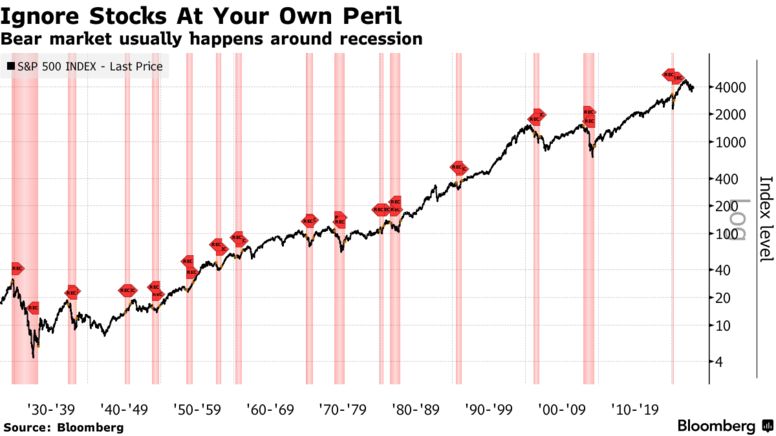From Lu Wang, “There’s an upbeat signal…” Bloomberg (Jan 18, 2023):
It’s as close to a sure-thing bet as markets ever offer. When the S&P 500 falls 20% or more, a recession is close behind. But economists whose dour calls for 2023 are being informed by this signal should look deeper into last year’s rout before betting the farm on it.
…
New analysis from researchers at Banque de France and University of Wisconsin-Madison shows treating the market as a whole when assessing its economic signals is less effective in part because benchmarks such as the S&P 500 can be skewed by richly priced companies or those deriving revenues from overseas. The performance of industrial and value stocks works as a better predictor for future growth, according to the study that covers a period from 1973 to 2021.
The paper in question is Chatelais, Stalla-Bourdillon and Chinn, “Forecasting real activity using cross-sectoral stock market information,” Journal of International Money and Finance (March 2023), discussed in this guest post. The forecasting power of a factor based on disaggregated stock indices outperformed the 10yr-3mo term spread and an aggregate stock index.
Figure 2: Out-of-Sample RMSE from the different estimated models
Note: On the graph are represented the Out-of-Sample RMSE of different models (the factor model or univariate regressions relying either on the aggregate DY, on the lagged IP growth or on the term spread). The predicted variable is the IP growth over 12, 18 and 24 months.
The article concludes:
Barclays Plc strategists including Venu Krishna have kept a model that tracks stock leadership and business cycles and by comparing them over time, seeks to offer a look into the market’s assessment of the state of the economy. Right now, the verdict is clear: no recession.
Unfortunately, as of July 2022, our model predicted a 2.2% decline in industrial production, in contrast to positive forecasts from the term spread and aggregate divident yield somewhat at variance with the sunny conclusion from Barclay’s Plc. As of December, US IP is down 0.5 ppts relative to June 2022.


Off topic – but their actions during the last 30 years – have convinced me that there are two things you can not trust the Republican party with: money and governance (now – I would add women’s healthcare.and private choices of all types). I also find it interesting that the media never pinpoints that it is the Republican party that causes this chaos (1995, 2011, 2013, 2023 – https://en.wikipedia.org/wiki/History_of_the_United_States_debt_ceiling – in reporting uses terms like “Congress” and “the House” ) and hence the Republican party never really gets held to account by their base voters – as Calculated Risk mentions https://www.calculatedriskblog.com/2014/08/short-memories.html
(Menzie – on Wisconsin – I heard a conversation with Joe Zepecki and Pat Kreitlow about how the WIGOP is turning Wisconsin into an economic back water with their repressive policies – women’s healthcare from 1849, a flat tax, etc., etc. https://civicmedia.us/podcast/the-abortion-ban-will-cost-wisconsin-hour-1/)
Good points. In case you missed my earlier comment:
pgl
January 20, 2023 at 7:14 am
All the new found fiscal responsibility from the House Republicans left me wondering about this ratio:
https://fred.stlouisfed.org/series/GFDEGDQ188S
Federal Debt: Total Public Debt as Percent of Gross Domestic Product
Obama left Trump with a debt/GDP ratio near 105%. Trump left Biden a debt/GDP ratio near 128%. As of the last quarter – this ratio is back down to 120%.
So if the House Republicans really gave a damn about fiscal responsibility – they are should shut the eff up and let the grown ups in this White House show these clowns how it is done.
interesting inference about republicans from one very focused view of a brief and hopefully unusual pandemic time period on a single set of data
Anonymous: Please read the paper. As is typical, we did robustness tests.
“There will be always be another generation of financial alchemists who think they can turn radioactive waste into gold.”
Bill McBride has a way with words!!
Thanks PGL – It is frustrating to me to hear economic policy reporters to still repeat the GOP canards over and over. And for media to keep pretending there are “moderate” Republicans https://twitter.com/mkraju/status/1616121814333243403?cxt=HHwWloC-kciOz-0sAAAA
Sure the pandemic created a false recession and the crypto bubble poured money into stocks. 2022 the bubble burst. Look at the 2013 trendline. Hence all your financial indicators failed. Over investment and financial crisis via excessive banking debt create recessions.
Also off topic but certainly a set back to Kimmy in North Korea and his hopes of being a nuclear weapon threat:
https://www.mirror.co.uk/news/world-news/tunnel-collapse-deals-devastating-blow-28996692
North Korea’s main source of uranium has been hit by a series of cave-ins and a tunnel collapse is so severe that it can be seen from satellite photos – dealing a blow to Kim Jong-un’s nuclear weapon ambitions. Jacob Bogle created a comprehensive map of the country from space and discovered the collapse in recent images of the Pyongsan mine. The mine is the regime’s main source of uranium ore, which can be refined into yellowcake and ultimately weapons-grade uranium. It is located less than a kilometre away from the only operational plant in North Korea that can process the ore into yellowcake. New satellite photos have captured the sudden appearance of large depressions in the earth close to the mine entrance.
Take it “for whatever it’s worth” from a finance major (bachelor’s) who’s watched stocks out of the corner of his eye all of his life. Stocks/equities are a latent indicator. And the man who spends his life researching otherwise is going down a deep deep deep rabbit hole.